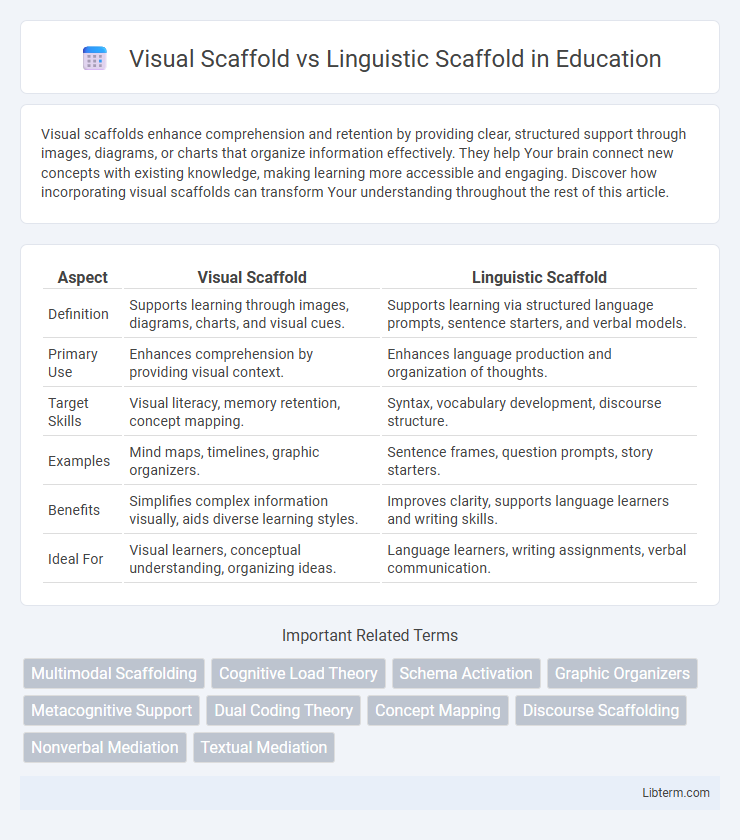Visual scaffolds enhance comprehension and retention by providing clear, structured support through images, diagrams, or charts that organize information effectively. They help Your brain connect new concepts with existing knowledge, making learning more accessible and engaging. Discover how incorporating visual scaffolds can transform Your understanding throughout the rest of this article.
Table of Comparison
| Aspect | Visual Scaffold | Linguistic Scaffold |
|---|---|---|
| Definition | Supports learning through images, diagrams, charts, and visual cues. | Supports learning via structured language prompts, sentence starters, and verbal models. |
| Primary Use | Enhances comprehension by providing visual context. | Enhances language production and organization of thoughts. |
| Target Skills | Visual literacy, memory retention, concept mapping. | Syntax, vocabulary development, discourse structure. |
| Examples | Mind maps, timelines, graphic organizers. | Sentence frames, question prompts, story starters. |
| Benefits | Simplifies complex information visually, aids diverse learning styles. | Improves clarity, supports language learners and writing skills. |
| Ideal For | Visual learners, conceptual understanding, organizing ideas. | Language learners, writing assignments, verbal communication. |
Introduction to Scaffolding in Education
Visual scaffolds enhance learning by providing students with imagery, charts, and graphic organizers that support comprehension and memory retention. Linguistic scaffolds involve structured language support, such as sentence frames and guided questioning, to develop communication and critical thinking skills. Both scaffolding methods facilitate gradual independence by tailoring instructional support to individual learner needs in educational settings.
Defining Visual Scaffolds
Visual scaffolds refer to graphical or spatial supports that aid learning by organizing information through diagrams, charts, or images, enhancing comprehension for visual learners. They provide a structured visual framework that simplifies complex concepts, making it easier to identify relationships and hierarchies within the content. Unlike linguistic scaffolds, which rely on verbal or written prompts, visual scaffolds leverage visual elements to activate prior knowledge and guide problem-solving processes effectively.
Understanding Linguistic Scaffolds
Linguistic scaffolds provide structured language support that enhances comprehension and communication by guiding learners through complex sentence formation and vocabulary use. This approach leverages conversation, questioning, and modeling to facilitate language acquisition and cognitive development in educational settings. Understanding linguistic scaffolds involves recognizing their role in promoting expressive and receptive language skills, crucial for academic success and social interaction.
Core Differences Between Visual and Linguistic Scaffolds
Visual scaffolds rely on imagery, diagrams, and spatial organization to support learning by enhancing comprehension and memory retention through visual representation. Linguistic scaffolds use structured language, vocabulary support, and sentence frames to facilitate understanding and expression in verbal or written communication. Core differences involve modality--visual scaffolds engage the brain's visual processing centers, while linguistic scaffolds target language acquisition and syntactic development.
Benefits of Visual Scaffolding for Learners
Visual scaffolding enhances learners' comprehension by providing concrete representations of abstract concepts, making complex information more accessible and easier to process. It supports memory retention through imagery and spatial relationships, which engage multiple cognitive pathways for deeper learning. Visual aids also foster independent problem-solving skills by offering clear, step-by-step guidance that learners can revisit as needed.
Advantages of Linguistic Scaffolding in the Classroom
Linguistic scaffolding enhances classroom learning by promoting critical thinking and verbal communication skills, enabling students to express complex ideas clearly. It supports language development and comprehension by providing structured and meaningful language input tailored to students' proficiency levels. This approach fosters deeper engagement with content through interactive dialogue, increasing student confidence and participation in discussions.
When to Use Visual Scaffolds vs. Linguistic Scaffolds
Visual scaffolds enhance comprehension and engagement for learners who benefit from images, diagrams, or graphic organizers, especially in subjects requiring spatial understanding or step-by-step processes. Linguistic scaffolds are best utilized when developing language skills, promoting vocabulary acquisition, or supporting literacy through sentence frames, word banks, and guided questions. Use visual scaffolds to simplify complex information visually, while linguistic scaffolds are ideal for fostering verbal expression and academic language proficiency.
Integrating Visual and Linguistic Scaffolds for Effective Learning
Integrating visual and linguistic scaffolds enhances cognitive processing by combining imagery with verbal explanations, which supports diverse learning styles and improves information retention. Visual scaffolds such as diagrams and charts complement linguistic scaffolds like detailed descriptions and vocabulary, creating a multimodal learning environment that facilitates deeper understanding. This synergy between both scaffolds optimizes comprehension, aids memory recall, and promotes higher-order thinking skills in educational settings.
Challenges and Limitations of Each Scaffold Type
Visual scaffolds face challenges such as limited accessibility for visually impaired learners and potential overreliance on imagery that may hinder deeper cognitive processing. Linguistic scaffolds present limitations including language proficiency barriers and difficulty in conveying abstract concepts without supportive visuals. Both scaffold types require careful integration to address diverse learning needs and prevent dependency that impairs independent problem-solving skills.
Best Practices for Scaffolding in Diverse Educational Settings
Visual scaffolds, such as graphic organizers and pictorial aids, enhance comprehension by providing concrete representations of abstract concepts, making them especially effective for visual learners and students with language barriers. Linguistic scaffolds, including sentence starters and vocabulary prompts, support language development and academic communication skills crucial in multilingual classrooms. Combining both scaffolds tailored to students' cultural and linguistic backgrounds promotes inclusive learning environments and optimizes cognitive engagement across diverse educational settings.
Visual Scaffold Infographic

 libterm.com
libterm.com